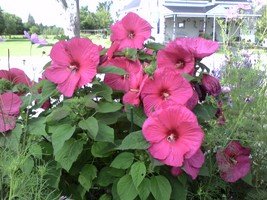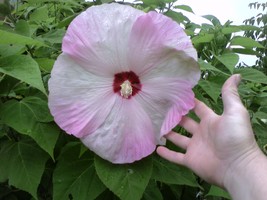





Hibiscus moscheutos. These eye-popping beauties are, surprisingly, not well known here. Many people can't believe they can grow here. Believe me when I say, they can, and do!! No special care required.
(Editor's Note: This article was originally published on February 10, 2008. Your comments are welcome, but pelase be aware that authors of previously published articles may not be able to respond to your quesitons.)
While sitting in front of the fan one hot, muggy afternoon, drinking a cup of coffee, I was startled by the sound of screeching tires outside. Fearing a cat had escaped from the closed in porch I ran out and  took a quick head count, decided all were present and accounted for. Only then did I look farther into the street. There was a man behind the wheel of a van, looking sheepish and apologetic while pointing to my front flowerbed. In the flowerbed was a woman with a camera taking pictures from every conceivable angle. She was capturing the plant in the picture to the left. Hibiscus moscheutos. Of course I had to go speak with her!! I ran back in and grabbed my coffee, preparing for a tour of the gardens. I figured if her hubby was the sort to come to a screeching halt for her to take a photo, he wouldn't mind waiting for her to take a little stroll. He might even join us. He didn't, deciding to stay in the air-conditioned comfort of the van.
took a quick head count, decided all were present and accounted for. Only then did I look farther into the street. There was a man behind the wheel of a van, looking sheepish and apologetic while pointing to my front flowerbed. In the flowerbed was a woman with a camera taking pictures from every conceivable angle. She was capturing the plant in the picture to the left. Hibiscus moscheutos. Of course I had to go speak with her!! I ran back in and grabbed my coffee, preparing for a tour of the gardens. I figured if her hubby was the sort to come to a screeching halt for her to take a photo, he wouldn't mind waiting for her to take a little stroll. He might even join us. He didn't, deciding to stay in the air-conditioned comfort of the van.
She and I got to talking, and she asked what was the name of this beauty. I told her it was a hardy hibiscus. Here is where she got confused: she couldn't get the tropical version out of her head, so I took her to see my braided one and tried to explain the difference. The tropical kind, Hibiscus rosa-sinensis, can't be subjected to cold. There is a wonderful article on those beauties by our own Islandshari here. The hardy hibiscus, can withstand months of freezing, covered in snow even. Hard to believe eh? She thought so too. I offered her and her husband a coffee, she declined with a brief look of disbelief and pulled a frozen bottle of water from the van. People just can't grasp that drinking something hot, when you yourself are hot, makes you feel cool. But, that's a different story altogether.
Back to the hibiscus at hand. I took her for a short tour, trying to focus on the Hardy Hibiscus scattered all around. I explained to her that, yes, they are planted there permanently. Yes, they do come back every spring in our zone 5a conditions. We have had temperatures in the winter down to -30C (-22F) and they still keep coming back, bigger and better every year. I don't give them any special treatment in the fall, no mulch, no burlap wraps, fend for yourself. That's the kind of gardener I am. And they come back. During the hottest summer days, they may need a drink if it hasn't rained in a while. They can get droopy looking if they get too dry, but other than that, nothing. I don't even fertilize them. They are one of the last of the perennials to poke their heads up in the spring. Just when you may think they have succumbed to the ravages of winter, give them two, or three, more weeks. They are surprisingly fast growers once they start. I have never tried to divide them, but they start easily from new shoots, in water or soil. I gave the lady a few I had in pots out back to take home with her. As they get older and bushier they might require staking. I push bamboo stakes in the ground in 4 or 5 places around the plant and wrap whatever I have handy around the stakes, like a fence. The blossoms, which are dinner plate in size, do not appreciate wind. No worries though, since they are covered in buds, with open flowers daily from the end of July right up until frost.
and they still keep coming back, bigger and better every year. I don't give them any special treatment in the fall, no mulch, no burlap wraps, fend for yourself. That's the kind of gardener I am. And they come back. During the hottest summer days, they may need a drink if it hasn't rained in a while. They can get droopy looking if they get too dry, but other than that, nothing. I don't even fertilize them. They are one of the last of the perennials to poke their heads up in the spring. Just when you may think they have succumbed to the ravages of winter, give them two, or three, more weeks. They are surprisingly fast growers once they start. I have never tried to divide them, but they start easily from new shoots, in water or soil. I gave the lady a few I had in pots out back to take home with her. As they get older and bushier they might require staking. I push bamboo stakes in the ground in 4 or 5 places around the plant and wrap whatever I have handy around the stakes, like a fence. The blossoms, which are dinner plate in size, do not appreciate wind. No worries though, since they are covered in buds, with open flowers daily from the end of July right up until frost.
By this time, the lady's husband was looking like he may doze off right on the steering wheel. She figured she had better get moving. I figured she had a pretty good husband there. She went away with a few Hibiscus moscheutos of her own, among a few other perennials I had potted up to wait for new homes.
So please, all of you northern gardeners, look for this beautiful perennial. I have found them in garden centres, mistakenly labelled as annuals. The leaves are easy to spot. The stems are red. They are worth it -- traffic stopping beauties that are easy to care for. And, they WILL survive the winter.
Copyright © www.100flowers.win Botanic Garden All Rights Reserved